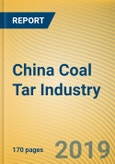China's Coal Tar Output will Still Edge Down by an Estimated 0.5% in 2019 and Pick Up in Future, Expectedly to more than 22 Million Tons in 2025
Coal tar is a key product in coking sector. In 2018, China produced around 20 million tons of coal tar, a YoY drop of 2.4% largely due to a lower operating rate of coal tar producers that had to be subject to the environmental policy. Coal tar output will still edge down by an estimated 0.5% in 2019 when capacity optimization and production curtailment persist in the industry. Yet as capacity gets upgraded and demand increases, coal tar output will pick up in future, expectedly to more than 22 million tons in 2025.
Segment: of China’s coal tar products, over 70% are high-temperature coal tar, a by-product from coke production. High-temperature coal tar output is predicted to approximate 16.8 million tons in 2025, compared with 15 million in 2018. Curbing production in China has brought about short supply of such product (apparent consumption ranged at 20 million tons in 2018) and a capacity utilization rate of less than 70%. Medium temperature coal tar whose output reached a mere 3.86 million tons in 2018 saw an even lower capacity utilization rate of below 30%.
Price: China’s coal tar price showed a upward mobility from 2016 to 2018, hovering at RMB3,000-4,000 per ton in 2018. The price hike resulted from tight supply. There is little possibility of a drop in coal tar price in the next two years as environmental protection campaigns which started in 2018 will last to 2020, but the price will rise at a limited rate for higher price has made downstream producers unprofitable.
Application: over 55% coal tar is utilized in deep-processing field where most players, however, have gone into the red due to coal tar price increase, thus demanding less. The demand from deep-processing domain for coal tar stood at roughly 9.6 million tons in 2018, down 7.7% from a year earlier, but is predicted to rise a bit in 2019 as part of new deep-processing capacity becomes operational. Carbon black driven by the growing tire market in recent two years generates the rising demand for coal tar, expectedly needing more than 6 million tons in 2019.
Coal tar and deep-processing industry features low concentration and scattered capacity with CR10 being less than 30% in China. Baoshun Technology as the coal tar deep-processing enterprise boasting largest production capacity in China, seized a market share of just 4.3% in 2018. The capacity optimization of coal tar makes for a higher concentration of the industry.
The report highlights the following:
- Coal Tar (definition, classification, application, industrial chain, etc.);
- Coal Tar (development environment, market size, market structure, import & export, market price, development tendency, etc.)
- Upstream coal and coke (market size, market structure, market price, import & export, etc.);
- Downstream deep-processing market size, imports & exports, market price, etc.;
- Coal tar industry patterns by regions and competition among enterprises, etc.;
- Three foreign and twelve Chinese coal tar and deep-processing enterprises (operation, coal tar business, etc.)
*The Chinese Version of this Report is Available on Request.
This product will be delivered within 3-5 business days.
Table of Contents
Samples

LOADING...
Companies Mentioned
- Baoshun Technology Co., Ltd.
- Baotailong New Materials Co., Ltd.
- Guanghui Energy Co., Ltd.
- Huanghua Xinnuolixing Fine Chemical Stock Company Limited
- JFE Zhenxing Shandong Chemical Company Ltd
- Jiangxi Black Cat Carbon Black Inc., Ltd.
- Koppers
- Nippon Steel & Sumikin Chemical Co. Ltd
- RüTGERS Group
- Shanghai Baosteel Chemical Co., Ltd
- Shanxi Coking Group Co., Ltd.
- Shanxi Hongte Coal Chemical Industry Co., Ltd.
- Shanxi Yongdong Chemistry Industry Co., Ltd.
- Shenmu Tianyuan Chemical Co., Ltd.
- Wuhan Iron and Steel (Group) Corp.
Methodology

LOADING...








